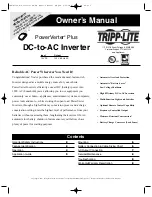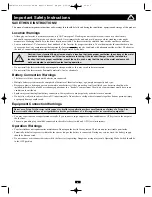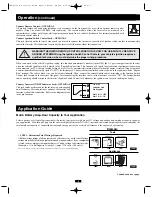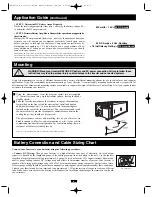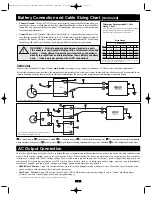
Indicator Lights
Your Inverter is equipped with a simple, intuitive, user-friendly set
of indicator lights.
LOAD LOW/MED/HIGH LEDs:
These three lights show the
power demand on your Inverter.
LED Function with Switch in ON or REMOTE Position
LEDs Illuminated
Load Level*
Green
0% - 50%
Green & Yellow
51% - 75%
Yellow
76% - 100%
Red
101% - 125%
Flashing Red (2/second)
Overload
Flashing Red (4/second)
Overload
(Inverter shutdown)**
All three lights off
Inverter off
* Levels listed are approximate and vary with application. ** Inverter shutdown protects
inverter, batteries and equipment from possible damage due to overload conditions.
BATTERY HIGH/MED/LOW LEDs:
If the operating mode
switch is in the ON or REMOTE position, the LEDs indicate the
approximate charge level and voltage of your connected battery
bank and alert you to several fault conditions.
LED Function with Switch in ON or REMOTE Position
Approximate Battery Charge Level*
LEDs
Battery Capacity
Illuminated
Green
91%–Full
Green & Yellow
81%–90%
Yellow
61%–80%
Yellow & Red
41%–60%
Red
21%–40%
Flashing Red (2/second) 1%–20%
Flashing Red (4/second) 0% (Inverter
shutdown)**
* Levels listed are approximate. Actual conditions vary depending
on battery condition and load. ** Inverter shutdown protects battery
against damage due to excessive discharge.
Fault Condition
LEDs
Fault
Illuminated
Condition
All three lights
Excessive discharge
flash slowly*
(Inverter shutdown)
*Approximately ½ second on, ½ second off. See Troubleshooting section. Inverter shutdown
protects battery against damage due to excessive discharge.
Additional Connections—Optional
Set Battery Charge Conserver (Load Sense) Dial—OPTIONAL
In order to save battery power, the Inverter automatically shuts off in the absence of any power demand from connected
equipment or appliances (the electrical load). When the unit detects a load, it automatically turns on. Users may choose
the minimum load the Inverter will detect by adjusting the Battery Charge Conserver Dial (see diagram). Using a small
tool, turn the dial clockwise to lower the minimum load that will be detected, causing the inverter to turn on for smaller
loads. When the dial is turned fully clockwise, the inverter will operate even when there is no load. Turn the dial
counterclockwise to increase the minimum load that will be detected, causing the inverter to stay off until the new minimum
load is reached.
Note: the factory setting for the dial is fully clockwise. However, based on the threshold load to which you’d like the inverter to respond, you should adjust the dial counterclock-
wise to reduce its sensitivity until the inverter is active only when connected equipment or appliances are actually in use.
4
1
2
3
4
5
6
7
1
1
2
3
4
5
6
7
1
1
2
3
4
5
6
1
2
3
4
5
6
Resetting Your Inverter to Restore AC Power
Your Inverter may cease supplying AC power in order to protect itself from overload or to protect your electrical system.
To restore normal functioning:
•
Low Battery Shutdown Reset:
Set switch to "OFF" and run vehicle engine to recharge battery. When battery is adequately charged, set
switch back to "ON" or "REMOTE."
•
Overload Shutdown Reset:
Set switch to "OFF" and remove some of the connected electrical load (ie: turn off some of the AC devices
drawing power which may have caused the overload of the unit). Wait one minute, then set switch back to "ON" or "REMOTE."
•
Output Circuit Breaker Reset:
Alternatively, check output circuit breaker on the unit's front panel. If tripped, remove some of the
electrical load, then wait one minute to allow components to cool before resetting the circuit breaker. See Troubleshooting for other
possible reasons AC output may be absent.
Operation
(continued)
200702194 PowerVerter DC-AC Owner’s Manual CH.qxd 2/23/2007 4:02 PM Page 4

